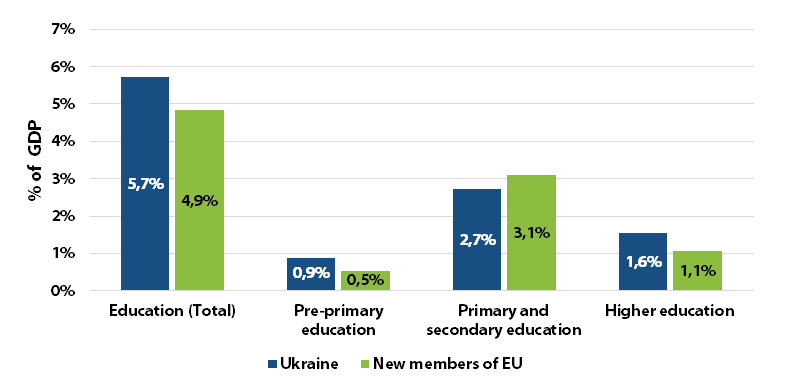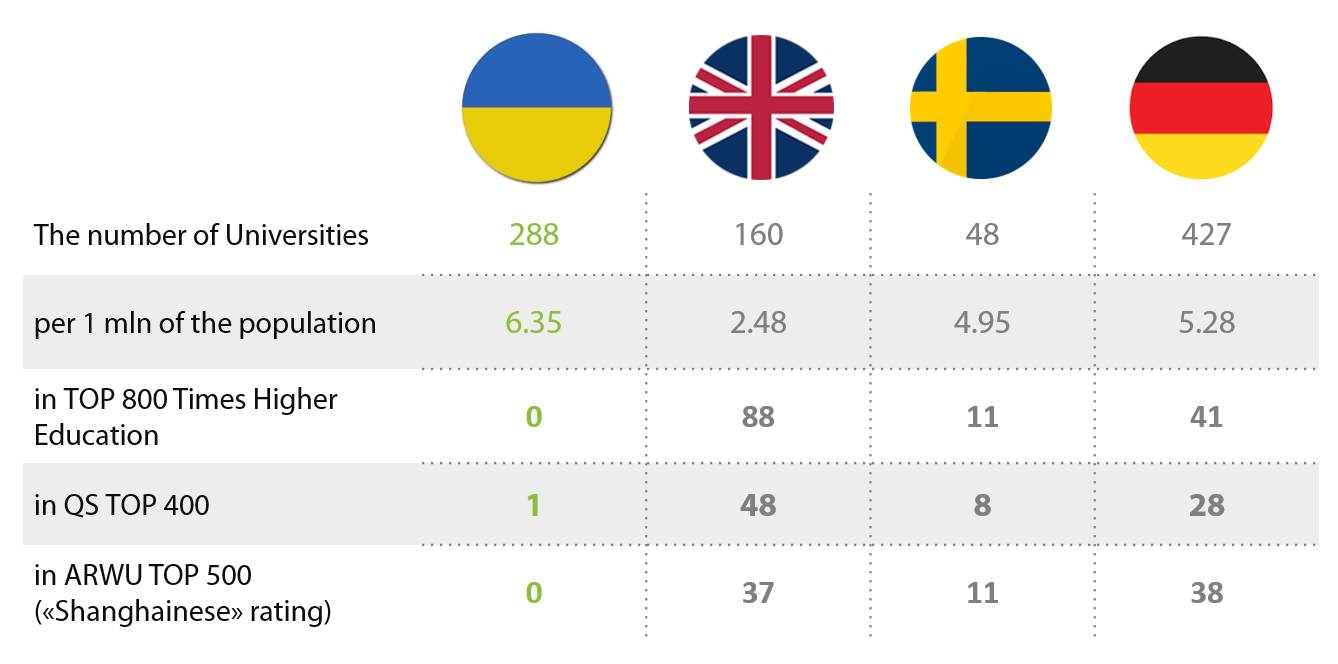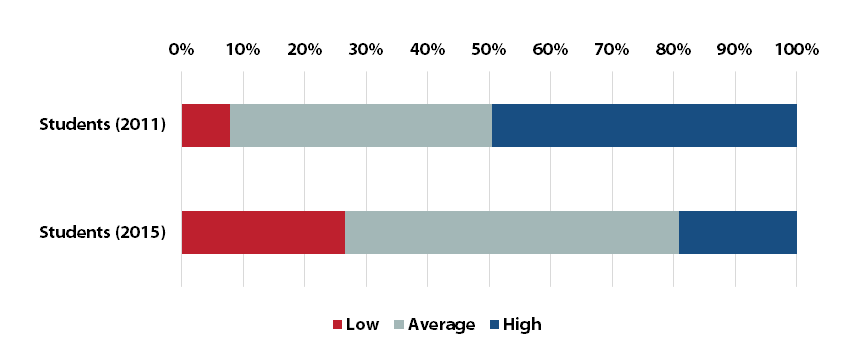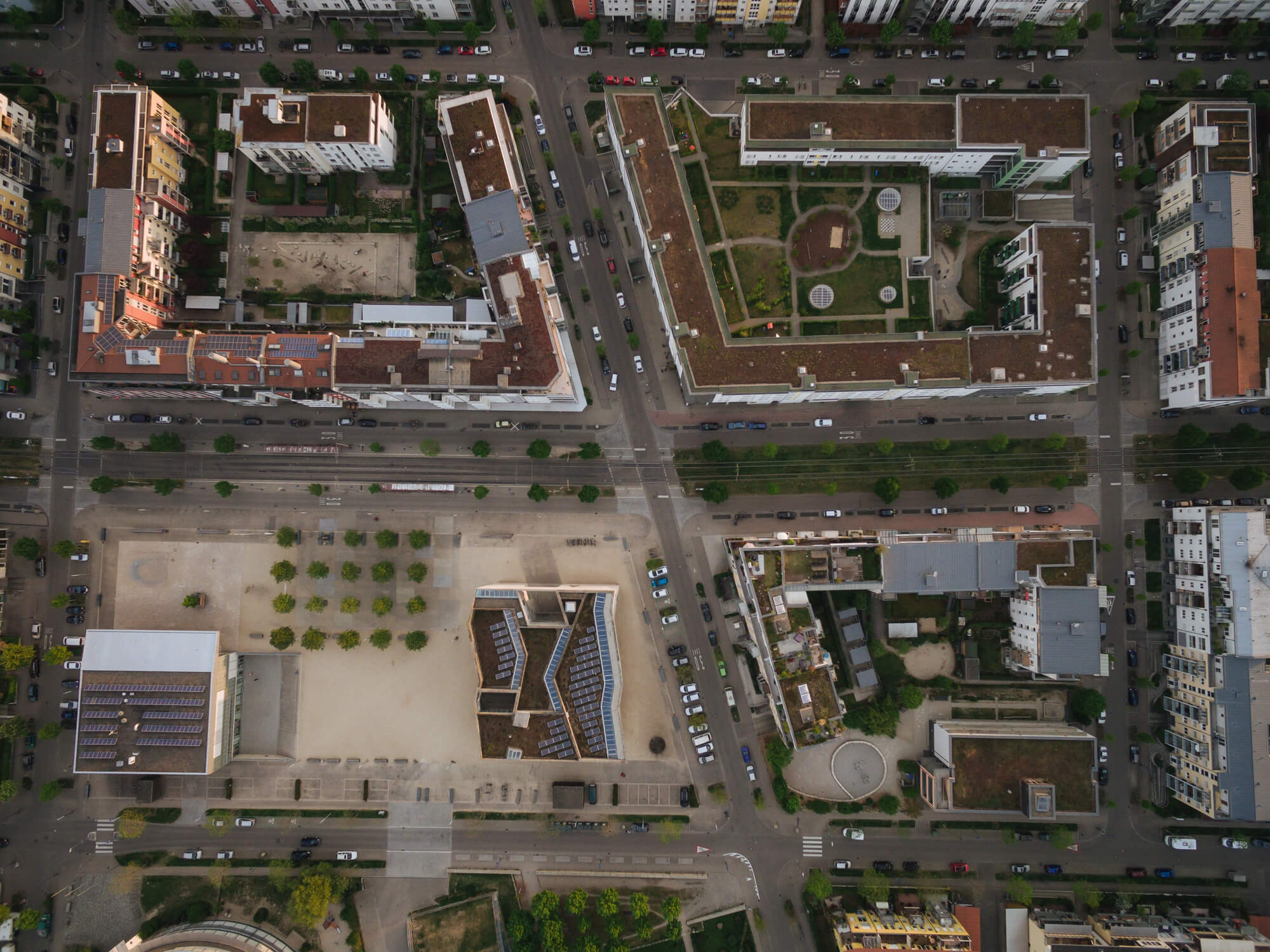Ukrainian government officials like bringing up the fact that Ukraine spends no less than European countries on education (as a percentage of GDP). This is true. However, they never mention the other side of the coin – that the money is spent very inefficiently, and the quality of both secondary and higher education keeps deteriorating every year. What are the educational system’s biggest weaknesses that rob the country of its future?
The state may and should stimulate economic growth and accelerate reforms using its main instrument – the state budget. However, currently the budget is used not for achieving socially important results but for funding the outdated processes that don’t have any formal performance indicators to evaluate the effectiveness of public spending.
In 2016, the state spent almost 6% of country’s GDP on education [1] – a rather significant share of public expenditures, surpassed only by government spending on social programs. Abnormalities in the financing and [the lack of] development of education and science have been accumulating over decades. The budget programs have neither explicitly stated objectives reflecting human capital development needs, nor performance monitoring mechanisms. According to the established indicators, it is impossible to determine whether a given government program is efficient or not, or to understand what exactly the taxpayers’ money is spent on, or whether the spending should be increased or decreased.
Presently, these abnormalities have reached pandemic proportions and require immediate changes in governmental policy.
Figure 1. Education expenditures in Ukraine and the countries-new members of EU, the recent available data (Ukraine – 2016*), % of GDP

* Consolidated budget of 2016, execution. Source: World Bank, The Treasury of Ukraine.
Higher education
Ukraine can pride itself on its high (according to the world standards) levels of educational expenditures, which result in higher percentage of people with higher education, yet bring no increase in labour productivity or employer’s level of satisfaction with the quality of workforce.
The reason for the above imbalances is that for years the budgeting process has completely disregarded the excising demographic trends, such as falling birth rates, urbanization, etc. and failed to adequately meet the actual market needs for professionals with specific knowledge and skill sets.
For example, the number of children aged 15-19 years decreased by 41% during 2000-2015, while the number of students – only by 8%. Gradual reduction in the number of students began late and has been very slow. Thus, according to the latest available data, as of 2013, 80% of the Ukrainian youth held higher education degrees. In 2016, the situation did not change because, according to the admission statistics of Universities, 80% of school graduates were admitted to Universities, in comparison with 50% in 2000.
The upshot of this is a significant gap between the employer requirements and the level of education in Ukraine: 30% of Ukrainians feel overqualified for the job they are currently performing [2].
Another imbalance – during 2010-2015 the total number of students diminished by 33% while the number of students funded from the state budget – only by 19%. In 2016, more than a half of students – 51% of total – were educated at the expense of the state, compared with 38% in 2010, The number of students per one teacher (including full-time (day), evening and correspondence study) amounted to approximately 11 in 2015, while the same indicator in European countries averaged 15.4 in 2013.
Table 1. Selected indicators of higher educational system in Ukraine
| 2000 | 2010 | 2015 | Changes in 2010-2015, % | |
| Number of Universities (III–IV level of accreditation), including: | 298 | 330 | 288 | -12,7% |
| State-owned | 208 | 231 | 208 | -10% |
| Privately-owned | 90 | 99 | 80 | -19,2% |
| Total number of students, 000s | 1 363 | 2 067 | 1 375 | -33,5% |
| In state-owned Universities, 000s | 1 194 | 1 810 | 1 259 | -30,5% |
| State budget funded | – | 799 | 649 | -18,7% |
| % of students, state budget funded | – | 39% | 47% | – |
| Number of teaching staff, 000s | н/д | 136 | 118 | -13% |
| Number of students per one teacher | н/д | 15,25 | 11,68 | -23,4% |
Source: State statistics service. * Own calculations; excluded data of temporarily occupied territory of Crimea and Sevastopol.
This multitude of distortions originates from the inefficient structure of public expenditures on higher education.
Higher education (the Universities of III-IV level of accreditation in particular), are funded through Ministry of Education. In Ukraine, the level of public expenditure on higher education amounts to 1.1-1.4% of GDP, while in other developed countries this indicator is lower – close to 1% of GDP.
60% of public expenditures on higher education account for remuneration, while in the countries – new members of EU, this share is 66%. Another 32% of public expenditure on higher education goes to provide stipends (educational allowances) [3] – an exceptionally high indicator; in EU countries, such expenditures account for a mere 17%.
One more inefficiency within this distribution ensues, as a greater number of students tend to come from wealthy families, and they end up being recipients of stipends (educational allowances) from the state. During the survey, only 12% of students identified themselves as those who come from poor families, while between the ages 14-35 there were 46 (data from the GfK survey “Youth of Ukraine”). In 2017 budget, the sum for educational allowances was increased up to UAH 5 billion, which is UAH 1.5 billion more than in 2015 [4]. Ministry of education allocated UAH 4 billion for academic (=merit-based) educational allowances, while Ministry of social policy allocated another UAH 1 billion for social educational allowances (=need-based financial assistance). Social educational allowances will be awarded by categories (?) without verification of the actual financial needs, and academic ones – according to the achievements to the top 40-45% of the students.
The result of this flawed system of public spending, as well as the inflexible remuneration policy and capital expenditures program, is a vast number of the Ukrainian universities holding extremely weak competitive positions in the world. (Figure 2).
Figure 2. The number and quality of higher educational establishments in Ukraine, Great Britain, Sweden and Germany

Source: www.educationuk.org, www.uka.se, www.destatis.de, QS World University Rankings, THE World University Rankings, ARWU World University Rankings
Students are becoming exceedingly unsatisfied with the level of higher education (Figure 3) and choose to study abroad. During 5 years between 2010 and 2015, the number of Ukrainian students studying abroad doubled – from 28,000 students to almost 60,000.
Figure 3. Students’ evaluation of higher education quality

Source: the results of the student survey conducted by Fund “Democratic initiatives”. It demonstrates the statistics of answers to the question: How would you rate the general quality of higher education in Ukraine?”. The survey was conducted in 2011 and in 2015.
Secondary education
Similar to higher education, Ukraine’s secondary education system suffered from inflexible reactions to demographic changes over the years. From 1991-2015, the number of pupils decreased almost by half. However, the number of schools was reduced only by 18%, and the number of teaching staff was cut only by 10%. As a result, the number of pupils per teacher per school decreased considerably.
Presently, the number of pupils per teacher remains at the extremely low level – approximately 9. In the low-income countries (where Ukraine belongs according to the World Bank classification) this indicator is 28 pupils, and in the high-income countries – 13. However, it is necessary to take into consideration a significant difference between urban and rural areas. An urban school has twice as many students per teacher and four times as many pupils per school than a rural one. This indicates another imbalance: in addition to disregard for general demographic tendencies, education policy failed to take into account urbanization trend, the effect being inefficient spending and a decline in the quality of educational services.
Table 2. Selected indicators of system of secondary education in Ukraine
| 2000 | 2010 | 2015 | Changes in 2010-2015, % | |
| Number of schools, total | 21 455 | 19 617 | 17 337 | -11,6% |
| urban areas | 6 992 | 6 681 | 5 669 | -15,1% |
| rural areas | 14 463 | 12 936 | 11 668 | -9,8% |
| The number of pupils, total | 6 436 232 | 4 090 906 | 3 783 150 | -7,5% |
| urban areas | 4 341 230 | 2 748 254 | 2 585 942 | -5,9% |
| rural areas | 2 095 001 | 1 342 652 | 1 197 208 | -10,8% |
| Number of teachers, total | 551 754 | 492 580 | 444 089 | -9,8% |
| Number of pupils per school | 301 | 210 | 219 | 4,5% |
| urban areas | 631 | 420 | 466 | 10,8% |
| rural areas | 145 | 104 | 103 | -1% |
| Number of pupils per teacher | 11,7 | 8,3 | 8,5 | 2,5% |
| urban areas | – | 10,4 | 11,0 | 6,5% |
| rural areas | – | 5,9 | 5,7 | -3,4% |
Source: State statistics service, own calculations * Own calculations, exluded data of temporarily occupied territory of Crimea and Sevastopol
Thus, even with a smaller number of children, the quality of education in rural areas is subpar. The relative quality of educational process could be indirectly assessed by the gap in the EIT results of urban and rural areas. In 2016, according to the data of the Ukrainian Center of Educational Quality Assessment, the percentage of school graduates who passed exit exams at high and sufficient level was 68% in Ukrainian language, 45% in Ukrainian History, and 56% in Mathematics; yet in rural areas these indicators were 23%, 28% and 37% respectively. These results arise not only from the outdated technological base and unqualified teachers in rural areas, but possibly from higher availability of IET tutors in urban areas.
Given this situation, at the end of 2016 the state initiated the process of establishing the network of reference schools and their branches: primary schools remain in villages, but starting from the 5th grade on, the children attend reference schools (reference establishments are founded by local authorities on the premises of a few existing schools selected on a competitive basis). The state is responsible for providing the school buses and building the necessary roads. A reference school should have full material and technical resources, no less than 360 pupils and no less than 2 branches, and the principal of the school is appointed on competitive basis. 137 establishments with 360 branches have started to work since 1 September 2016.
The recent data on Universities admission in 2016, demonstrate one more extremely negative trend: graduates with the lowest IET results enter Universities to major in education. At the same time, one can not assume the top graduates would stay to become school teachers, due to the low level of salaries and low occupational prestige. Thus, the retired teachers are replaced with those young teachers, who graduated at the bottom of the class and could not find any other job after graduation. This cannot but have the detrimental effect on the quality of secondary education. and is fully dependent on its funding.
In 2017 there have been some changes in this respect. The minimum salary of a teacher will be UAH 3,960 (UAH 2,000 more more than in 2016) and, according to the Prime Minister, the teacher’s salary will increase by 50% on average, In addition, majoring in “secondary education” and “special education” will be encouraged by higher levels of stipends (educational allowances). Thus, one can expect more competitive admission to the teaching majors, as well ability to attract the best graduates for teaching positions in the regions. The new program of Cabinet of Ministers, which is undergoing public discussions now, stipulates plans to revamp secondary education, which includes, among others, changes to the standards, content of educational programs, and improvements in teachers’ trainings.
Focus on reform and optimization
Structural reform in education is absolutely necessary in order to increase gains from the public spending.
Firstly, it is necessary to change the approach to budgeting. In addition to stating the Government’s short- and medium-term plans, we need to have a corresponding reflection of these plans and target performance indicators in specific documents. We need to have functional review and complete implementation of program-target (?) method of budgeting. This method is claimed to be currently in use, but in reality the results are far from desired Moreover, the budgetary programs do not stipulate that expenditures should serve a purpose of socially important results – for example, the indicators of product efficiency or quality may include the data on the number of processed letters, complaints or issued regulations, that reflects internal processes, but and does not demonstrate achieving of public goal. Target indicators should be simple, measurable, and few in number. The state bodies , for whom they are developed as target indicators, should not be able to manipulate the numbers (.i.e. they should be calculated by other body based on the data provided by the third party). They should reflect general objective of budget holder performance, which is stated in the regulation and/or other regulatory acts.
Table 3. Selected indicators of system of secondary education in Ukraine
| NAME OF THE PROGRAM | SELECTED CURRENT INDICATORS OF PRODUCT AND QUALITY | Comments |
| General management and administration in the sphere of education and science | The number of received and processed correspondence (orders, letters); the number of considered appeals, complaints from citizens of Ukraine; the number of completed and received regulations by Ministry of education; relative share of orders executed on time in their total number; relative share of approved decisions of Certifying Board on awarding academic degrees in the total number of theses and certification cases submitted for consideration | The results should be some indicators of education quality, which could be assessed relatively easily and cheaply. In addition, that would reflect positive result for the society, and would demonstrate how successful the implementation of educational policy was. For example, rating of the country in PISA, how popular University graduates are on the labour market, whether the number and qualification of graduates matches the requirements of the market, the place of Ukraine in the global competitiveness rating for educational indicators |
| Training of specialist in higher educational establishments of III and IV level of accreditation and ensure their activities without practice. Total funds – 19,3 billion UAH. | Average annual number of full-time students; average annual number of scholarship holders; the number of graduates of orphans who would be paid one-time financial support upon employment; the percentage of students, who would receive an appropriate certificate of education; relative share of employed full-time graduates in the total number of full-time students | In fact, the current objective of the program is to administrate state quotas. It does not say anything about quality or impact on education policy now. The possible indicators of social results here could be gap reduction (or expansion) between current staff members and labour market requirements, graduates competence assessment by employers, the results of young people surveys (1-2 years after graduating University) on whether they work in the degree field, when Ukrainian Universities get into world ranking or their popularity among foreign students. |
| Physical and sport training of pupils and students. Total funds – 82 million UAH. | The number of man-work units, trainings organized by TSSHVSM in Ukraine; the number of TSSHVSM trainees, who will take І-ІІІ prize at the national competitions this year | Responsibilities and assets should be transferred to Committee for physical education and sports of relevant Ministry, resources of physical education are being dispersed now. |
| Advanced training of teaching staff and specialists in the food processing and agriculture industries. Total funds – 33,7 million UAH. | Average annual number of participants, who improve their qualification; relative share of persons who receive an appropriate certificate of education in the total number of participants, who improve their qualification | It is impractical to fund advanced training of private entities employees on taxpayers’ expense. It is necessary to leave only advance training for educators in the framework of Ministry of science and education, and to establish appropriate indicators, which would correspond advance-training objective – for example, measuring increase in performance efficiency or the number of promoted people and etc. If other state institutions would like to improve qualification of their employees, they would need to do this within their own budgetary programs and to buy educational services on competitive bases from state and private executors. |
Source: registration document of Ministry of science and education budgetary programs, CES comments. More detailed analysis of budgetary program in CES research
Secondly, it is necessary to implement a number of functional changes at each level of educational system
The Government action plan on secondary education, proposed for public discussion, already contains the plan on developing new academic programs a plan on developing new academic programs, establishing a system of monitoring education quality and teachers training and re-training. Despite the fact that the plan correctly states the main issues, specified above, the key implementation steps include mostly monitoring the current state and adoption of documents, while the real measurable results remain undefined ( specifically, they are defined in un-measurable form, i.e., “Improving education quality, declaring child-centered approach, decentralization of management, improving educational qualification of the youth, multicultural tolerance and integration of different education programs”). After monitoring, those results should be defined in quantitative form and added to Government programs and to the budgetary programs of the Ministry of education.
The situation is more troublesome in higher education. In our point of view, excessive bureaucracy and high dependence on the central apparatus in making minor decisions (i.e. teachers’ remuneration, size of educational allowances, purchasing equipment) hamper the development of universities. Current budgetary programs, aimed solely at the execution of state quotas, can not answer the paramount questions: what should be the future higher education in Ukraine; how could Ukrainian universities compete with foreign ones in attracting students; how could Ukrainian Universities provide quality education, leading Ukraine’s human capital to the competitive world levels; how the education market should interact with the labour market.
Unfortunately, the new Government program does not provide answers to these questions either. It is focused on the challenges of corruption and academic dishonesty, which is plausible, but will not fundamentally, change the rules of the game. In our of view, higher education in Ukraine is in the need of much more radical and comprehensive reform. If the approach “money follows a student” has been partially implemented, there is still a long way before we see Universities’ self-government and a truly competitive market for providing educational services. One can consider the option of Universities’ corporatization (creation of supervisory boards, similar to the state-owned companies), providing Universities with broad financial autonomy, while establishing tight control on public expenditure. For instance, educational establishments should provide educational allowances to the most talented students at their own expense within their own motivation programs. The same applies to the cost of dormitories, health care, transportation – University should be able to make independent decision on these expenses, based on the research of students’ motivation and the development of the unique strategy in the educational market. The aid for low-income citizens could be guaranteed by means of social policy in order to ensure equal access to education. It is necessary to reform state quotas, to ensure competition between state- and privately-owned establishments at the market, with the opportunity for students to spend a government grant on studying in both the privately- or state- owned institutions, by his/her own choice. At the same time, the problem of information asymmetry, which could potentially distort competition, should be addressed at the centralized level
Support of science at Universities requires separate policy: on what exactly the money is spent, what effect the government would like to achieve by funding the research, what resources are necessary in order to bring up new generation of scientists – present national policy does not have answers to all these questions.
Thirdly, decentralization has to start working – transferring decision-making and funding locally should create opportunity for local government to invest in technological resources (computers at schools, refurbishments, equipment for physics and biology labs, fringe benefits for teachers and etc.). At the same time, communities who want their children to get quality education, must take a firm hold of monitoring where the local budget money is spent and start actively influence this expenditure allocation.
Notes
[1] According to the data of the Treasury, during 12 months of 2016 129 billion of hryvna from consolidated budget were spent on education.
[2] Kupets, O. Education in Transition and Job Mismatch: Evidence from the Skills Survey in Non-EU Transition Economies. Kyoto Institute of Economic Research Discussion Paper No. 915, 2015
[3] According to 2015 results. The figures are provided from calculations of analytical center CEDOS based on Ministry of education and science data, which was received under official inquiry
[4] It was not possible to allocate money for educational allowances at budget presentation until 2017. That is why the figure for 2015 is represented, according to CEDOS calculations.
Attention
The authors do not work for, consult to, own shares in or receive funding from any company or organization that would benefit from this article, and have no relevant affiliations




